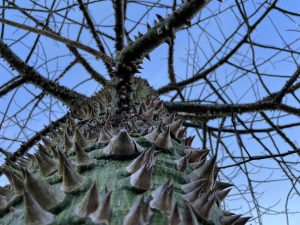The following series of columns entitled ‘Soil to Sky’ are an examination of five different facets of environment, structure, and life that are instrumental to trees in our forests and landscapes. Trees are instrumental to our wellbeing, both individually and collectively as a society. Healthy urban forests and natural areas are the responsibility of professional arborists, policy-makers, volunteers and individuals, among others. We will be sharing our enthusiasm with you in weekly installments and encourage you to become tree stewards, heralding forth the future of healthy trees.
Stem-by David Outerbridge
The bridge, more than just the intermediary, the stem is the heart of the plant, the center between roots and vegetation. Thin yet strong and at times flexible enough to hold the two together. The interchange between the gathering of water at the base and the absorption of sunlight through photosynthesis at the pinnacle. Sheathed in bark and cored in the foundational growth that the plant started with. The stem holds the memory and history of the tree in concentric circles that emanate out from the pith to heart wood, to sap wood, to the cambium layer finished in a sheath of bark that protects and prevents pests from accessing the flow of water and nutrients with the sap of the tree.

Over time the heart wood changes, it dies and is dead, preserved while everything else around it goes on living. The purpose that remains is structural, fibers that have a memory of each experience the tree has witnessed through years of life form the center of every growth that comes after the foundation for each building idea of interaction, indication of feast, famine, fire, and freeze. To some trees the timeline of a human life is just a fraction. These wise old beings such as the sequoia, and bristlecone pine live for hundreds or even thousands of years and within their hearts they hold stories once lived but not yet told.
The sapwood or xylem layer consists of living cells and provides a more flexible section by which to adapt to the current situation while providing capacity by moving water up from the roots to the leaves. The sap serves several purposes transport being the primary, but also tourniquet, for damaged trunks, a pesticide to fight against fungus, bacteria, and insects that confounds confuses burns and traps unsuspecting invaders. Humans have figured out how to use some of these such as rubber, maple syrup, toothpaste, and salve. At the very edge of the sapwood is the cambium layer. This minute area invisible to the naked eye is where the growth of the stem happens. Any damage by ringing or ripping the cambium layer causes the tree to die as any cellular formation happens in this slight margin. Just beyond the cambium in the yielding soft living bark layer is the phloem where the food manufactured in the leaves is transported down to the roots to barter in the soil.

Finally, the casing of the dead bark layer protects the stem and helps with water evaporation. There are so many forms and textures of bark that exist from scaly, rough patterned oak bark to the smooth gentle colorful skyward mosaic of rainbow eucalyptus, to thorny aggression of the cotton floss tree. Some barks are utilized by humans such as cork and cinnamon. The former fortunately survives the harvest and is carefully managed in ecosystems to ensure the ongoing preservation while the prior must be cut, stripped, and dried to produce curly rusty sticks of the spice that when savored or scented carries us to reminiscence.
 0
0
